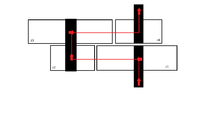For a school project I have drive something with a ratio of 2. How I accomplish this is completely up to me. I chose to do it with two sets of gears, as shown in the picture below. I tried to make it as clear as possible how the motion goes and which gear drives which. Now my problem is more mathematical since I am trying to figure out which single ratios are possible that equal 2 together (since there are two sets of gears) whereafter I can decide which are most suitable/optimal for my design.
With some logical thinking I know that the following ratios are possible:
[MATH]1/1 * 2/1[/MATH][MATH]4/5 * 5/2[/MATH][MATH]8/5 * 5/4[/MATH][MATH]4/3 * 3/2[/MATH]
However, I am looking for a more mathematical approach in figuring out if there are more gear ratio's suitable. To not have an endless quantity of data, 1/6 is the outer extreme.

With some logical thinking I know that the following ratios are possible:
[MATH]1/1 * 2/1[/MATH][MATH]4/5 * 5/2[/MATH][MATH]8/5 * 5/4[/MATH][MATH]4/3 * 3/2[/MATH]
However, I am looking for a more mathematical approach in figuring out if there are more gear ratio's suitable. To not have an endless quantity of data, 1/6 is the outer extreme.


